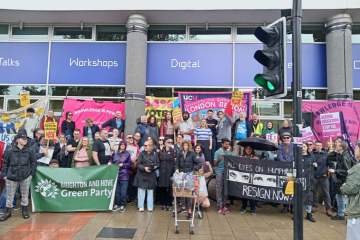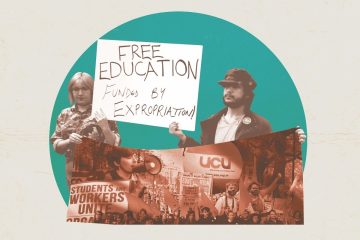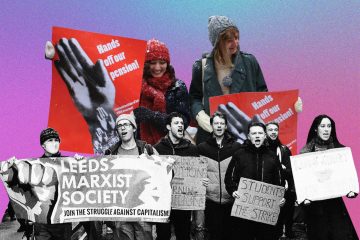by Daniel Morley (25th March 2013)
 In November 2010, the new Tory government was greeted by the largest and most militant student movement for decades. At the time, a brief wave of euphoria spread through the activist movement. The birth of a new generation of radicals had arrived.
In November 2010, the new Tory government was greeted by the largest and most militant student movement for decades. At the time, a brief wave of euphoria spread through the activist movement. The birth of a new generation of radicals had arrived.
That prognosis was not wrong. The consciousness of young people has changed dramatically, as shown by the growing interest in the Marxist societies that Socialist Appeal supporters have helped to establish across the country. However, even as this has taken place, the National Union of Students (NUS) leadership’s failure to show bold leadership has, temporarily, allowed this outburst of mass activity to dissipate. This has resulted in activity fizzling out and fracturing into small, ephemeral campaigns isolated from the mass of students. How should Marxist students conduct themselves in this period so that when the student movement takes off once again, they can win it to a revolutionary, Marxist programme linked to the organised working class?
Amongst student activists, there is a widely shared understanding that the NUS leadership has fallen very short of meeting up to its tasks. Student fees have rocketed, and the leadership rolls over and shows its belly. Terrified at the prospect of a militant student movement taking off and upsetting their smooth career path, as the movement of 2010/11 threatened to do, the NUS leaders failed to even organise a demonstration the following year. As a result, a layer of the student population has a general awareness of the leadership’s inadequacy. It is obvious that looking to the NUS leaders for meaningful leadership, a way forward, a programme of demonstrations and inspiring public statements, would be very naive. The desire to ‘do’ something, to re-start the mass movement of 2010/11, is strong.
This mood is a very good starting point. We have come a long way from the level of consciousness at the time of the introduction of top-up fees in 2004. But the danger is that, as a consequence of the lack of movement and initiative from the top, a small layer of activists can seek to generate activity themselves, so that they feel they are ‘doing something’. A romanticism for the militancy and occupations of 2010/11 can creep in and give rise to a desire to create one’s own movement, away from the stultifying NUS structures. The temptation to have created a little militancy, achieved something, can be powerful.
The attempt to substitute one’s own personal activity for the movement of the masses is dangerous because it inherently involves moving ‘away’ from the mass of students. It goes without saying that the mass of students were the indispensable part of the student movement. It was the mass character of the movement of 2010/11 that gave it its power. It is a serious mistake to imagine that creating artificial, small scale militancy is an end in itself, or that it can be the ‘spark that ignites a prairie fire.’
One example of this trend was on display during the recent NUS national demonstration on 21st November 2012, under the slogan ‘educate, employ, empower’, when activists at the University of London (ULU) staged their own demonstration in tandem with the NUS one.
This was held two years after the equivalent demonstration that kicked off the movement before – in the intervening year (2011), as mentioned above, nothing was organised by the NUS, and in that respect it is justified that a small layer of student activists organised their own demo that year. We want the same things – a militant and effective student movement. It is only in the methods used to achieve this that we disagree.
However, this demonstration called in 2011 was small and very London (and ‘activist’) heavy, as one would expect from a demo organised outside of the official structures. Responsibility for this weakness lies in the NUS leadership for refusing to organise a demo themselves. In 2012, however, the NUS felt obliged to organise another one, thanks to pressure from students around the country.
With all the legitimacy, national strength, financing etc., that the NUS brings, their commitment to calling a national demonstration is to be enthusiastically welcomed. Why, considering the leadership’s obvious half-heartedness in doing so? Why should we rely on these leaders? Because any demonstration with their backing has the potential to bring together tens of thousands more students than demonstrations organised by a small layer of well-meaning activists . The students participating in NUS demonstrations do not share the careerism and spinelessness of the NUS leaders. It is a display of student strength. Such marches give students confidence in themselves and lay the basis for an ongoing campaign.
If we are serious about challenging for a genuine, fighting NUS leadership , marches such as these present a golden opportunity – tens of thousands of angry students gathered together, open to hearing political arguments and solutions to the current crisis! What better time and place to dedicate our resources to a campaign explaining that this march is only the beginning, that if we are to achieve our goals, we need a fighting national student union committed to a socialist programme – nationalisation of big business to pay for free education – and the linking of the student movement to the labour movement to achieve this.
Marxists active in universities must concentrate their efforts on building for such opportunities. That means building a powerful network of Marxist activists in universities around the country. No doubt activists who helped organise the separate demonstration referred to above will have made some efforts in this direction. But if we are serious about transforming the NUS, what is required is a sustained, concentrated effort in this direction.
We must be absolutely clear, not only amongst ourselves but publicly also, that the fight against fees, debt, etc. is a political fight which can only be won by militantly challenging the government and the capitalist system nationally and internationally. That means that the national organisation of student unions, the NUS, is a key organisation in the battle. This question cannot be avoided.
Artificial militancy
For example, around the November 2012 NUS demonstration, leading activists at ULU (Michael Chessum and Daniel Cooper), holding two key elected positions on the student union, did not concentrate their efforts on using the demonstration as a platform in the fight for socialist policies in the NUS. Instead their efforts were mainly directed to hosting their own march at the same time. Although it is true that, in the end, the police gave this march permission, and it was thus able to eventually join the main one, that was extremely fortuitous – they only gave permission on the day itself.
Of course, we blame the capitalist state for restricting civil liberties and we defend the right for students and workers to march free of police interference. And we recognise the sincerity and positive work at ULU of said activists. But that does not make the strategy of organising separate demonstrations a correct one, since they are far more likely to be kettled, thus isolating the activists from the larger march. Flippantly doing so only plays into the hands of the NUS right-wing, who will rightly (though for the wrong reasons) accuse these activists of endangering students in the face of police brutality.
Orientating towards the mass of students gathered in the main march was clearly not a priority for the ULU activists. After having joined the main march half way through it, they then gathered the most ‘militant’ of students for another breakaway march. They did this because they felt that the NUS march’s route did not satisfy their urge for militancy, as it avoided Parliament. What this means in practice is that those activists were once more physically isolated from the rest of the students, who continued on the main march, for the sake of having an artificially ‘militant’ experience.
Certainly, the NUS must be criticised for organising a weak route. Clearly, they wanted to make sure no ‘uncontrolled’ student militancy broke out, sparking off a wave of protests and occupations as in 2010. But in order to do duty to their criticism of the NUS leadership, socialists must ask themselves what the most effective way of delivering this criticism is? Is it by diverting those already against the NUS leadership away from those still with illusions in this same leadership and into an ineffective stunt that has the consolation of being ‘militant’?
For years, left-wing student activists have made the mistake of calling for a new NUS to be built outside of and apart from the current one, which is apparently unsalvageable from the bureaucratic rubble. We have argued against such a strategy in previous articles. The strongest argument at the disposal of those who seek to build a new ‘democratic, radical’ NUS has been the point that, unlike in workers’ unions, the level of attachment the mass of students have to the NUS structures is very weak. But if that is so, we must judge the activists and left-sectarians by the same criteria. In other words, how ‘attached’ to radical left wing student campaigns and NUS alternatives are most students? In this comparison, unfortunately the left wing networks come out of the contest extremely poorly indeed.
If students are put off by the NUS leadership’s spinelessness, they are ten times more alienated by the left-activists they witness operating on their campus , who in the loose environment of campus life all too easily become small cliques. These groups, rather than concentrating their efforts on openly campaigning for socialist ideas, tend to gather like-minded, already existing activists together, who begin to speak only to one another and the other assorted ‘politicos’ on campus. They forget about the need to patiently argue for socialist ideas. Indeed they tend to avoid discussing the political needs of the movement for the sake of preserving the ‘unity’ of the activist clique, composed as it inevitably is of various viewpoints, from anarchist to left-reformist. This strategy makes building a strong, lasting and growing socialist tendency in the movement impossible.
The march on 21st November 2012 demonstrated very clearly the worth of mass organisations, even in the student movement. Unlike the rally outside ULU, the NUS-organised rallying point at Embankment contained thousands of students. It was a meeting point for all the contingents of students from around the country – Manchester, Sheffield, Newcastle etc., as well as London. This was only possible because it was NUS organised. The NUS is afterall a federation of (almost all) the individual student unions around the country.
The mood, independent of the wishes of the NUS leadership, was very militant and markedly more against the NUS leadership than two years previously. There was a carnival atmosphere. Here we have a textbook example of why socialists must never write-off mass organisations of workers, or for that matter students, however rotten the leadership.
For all their detachment from the rank and file, these organisations are still the only ones that have the power to bring together tens of thousands of workers or students. And, having been brought together, the movement constantly threatens to develop a life of its own. Thanks to the calling of the march, thousands of ordinary students can now chant slogans together, discuss, feel their collective strength etc, and in this way become conscious of the possibility of a more militant NUS. Thus effective opposition to the rotten leadership of the student movement can only come from within the NUS and the mass demonstrations they organise (in spite of themselves).
 How to win the NUS to a socialist programme
How to win the NUS to a socialist programme
As activists we must skillfully use every opportunity and step forward taken by the NUS leadership, knowing that they only take steps forward reluctantly. Our task, as Marxists, is to see in all concrete phenomena an opportunity to explain Marxist ideas in a positive and not an abstract way. If the NUS organises a march, however inadequate its route, we cannot afford the luxury of being ‘one foot in, one foot out.’ We must throw ourselves into it from the very beginning. Only in that way can our criticisms of, and alternative to, the NUS leadership effectively reach the mass of students gathered there.
Our aim is to put forward a clear socialist programme for the NUS by intervening in its activity as the best militants and defenders of students and the NUS. In this way we will gain credibility for correctly showing the way forward. On this basis Marxists can, eventually, challenge for the leadership of the whole union. Organising your own thing on the sidelines is a poor consolation for failing in the real task of winning the political battle of ideas within the NUS.
Achieving this is easier said than done. It is a concrete question, not one of simply adhering to these principles in words. Most activists, apart from those anarchists seen brandishing ‘Smash the NUS’ banners, agree that winning students over to an alternative, socialist programme for the NUS is a good idea. But what is actually required to make it happen?
The big rally at the beginning of the most recent NUS march is a very good example. Again, almost all activists would agree that leafleting rallies such as this, in support of the demonstration but also criticising the NUS’ lack of a fighting programme, is a good idea. But making it happen effectively is another matter entirely. It is not easy to leaflet 10,000 students (or more, for that matter, 50,000 as in November 2010) and make an impact on their consciousness. It is even harder to then sustain and follow up that impact in a campaign to lead the union.
To do so, what is required is a very large number of leafletters, meaning a strong organisation of militant students doing so in an organised manner – in other words, we need comrades from each of the student unions present on the march, travelling down with the rest of the students from their university. They need to work in advance of the demonstration, to help organise that student union’s trip to the demonstration by passing resolutions in favour of it. They need to have won the confidence of the most advanced students present. In the Marxist societies the comrades of Socialist Appeal are beginning this work.
The leaflets must not only contain good agitational material and demands, but should also be linked to a national organisation, with meetings organised in every university. If, instead of this preparatory work being done, the tens of thousands of students simply arrive and find a few London based activists they’ve never seen before, handing out leaflets for an organisation they are unfamiliar with and with no programme of meetings closer to home, the leaflets will make little impact. They will come across as abstract and impracticable.
The role of Marxist students
To achieve this, Marxists must build year in year out in preparation for such events. We have to spend each term time putting on meetings, educating a bigger and bigger layer of cadres in revolutionary theory. These cadres can then move resolutions in support of NUS demos (or calling for them) in their student union, and play leading roles in getting their student unions to organise for them. They must raise at every opportunity the need not just for demonstrations, but for a clear socialist programme in the NUS and at each university. They must play a leading role in linking the student movement to the labour movement in general and on campus. This requires years of patient work.
The lack of such preparatory work by left-wing activists was evident at this rallying point in the November 2012 demonstration, where tens of thousands of students were met by little or no organised left-wing force from within the movement. No one, apart from Socialist Appeal supporters, seemed to be raising the point that to achieve free education we need a socialist transformation of society. This problem was also evident in the big student movement of 2010/11, where left activists seemed to have no programme other than the endless calling of demonstrations, each one smaller than the last.
If a powerful national organisation of Marxist students had been built beforehand, it could have used the big demonstrations and occupations in 2010 as launchpads for a coordinated campaign in each student union, passing motions of no-confidence in the NUS leadership, and calling for student unions and those in occupation to send delegations into the local labour movements. These delegations would have thereby forged strong links of solidarity with workers, pledging to support any strike movement in defence of conditions and against cuts. They would have used the momentum and manpower of these occupations (which each involved hundreds of students) to leaflet local workplaces for mass anti-cuts meetings in each city, sponsored by the student unions.
Our comrades in Cambridge were able to do precisely this back in 2010, because they had spent years building a local base with weekly Marxist society meetings attracting larger and larger audiences. They helped organise and lead the building of a mass anti-cuts meeting during the student occupation which gathered together well over 300 local people, with hundreds more who had to be turned away because the room was too small! In those months, the militant student movement had the ear of the working class. It was front page news.
But the rest of the organised left have not spent their time preparing with weekly Marxist education meetings. Instead they have spent years organising ‘front campaigns’ in which the explanation of socialist ideas is pushed into the background. They have thus failed to educate and organise a solid layer of students around the country with the confidence to play the necessary role.
In the moment of truth, such groups had nothing to add to the student movement of 2010/11 other than more front campaigns. At the end of each demonstration, all they called for was another demonstration (to be organised by themselves, not the NUS), the same as the last. They were not able to raise the movement onto a higher level by using its momentum to transform the NUS, which was left untouched by these events. They were, as in November 2012, more interested in using the momentum from the initial NUS demo to simply call more demos lead by themselves. Eventually, nobody came on these demonstrations.
The reason they were unable to do so is that they had not prepared; had not educated themselves in the perspective of transforming the NUS into a fighting union with a socialist programme. By diluting themselves into vague front campaigns for short term success when the movement was small, they lacked the substance to use the movement when it was big as a platform for winning leadership of the NUS.
This tactic has behind it the false notion that in simply calling their own demonstrations and occupations without doing the preparatory political, open campaigning work, well-meaning activists can somehow ‘kick-start’ the mass movement. Of course activists can and must influence events, otherwise our entire activity would be a waste of time.
But the layers of organised activists in question count in their ranks literally no more than one or two hundred students across the country, if that, with only handfuls active from university to university. It must also be added that this small layer is organised very loosely and more often than not does not have a clear programme to which they adhere. The size of one’s forces determines the tactics one should pursue. Should such weak forces be used in a vain attempt to transform the class struggle through stunts and separate, small, but ‘militant’ demonstrations?
Trying to shout louder than your own voice will only make you hoarse. Far better to concentrate one’s efforts on educating more and more students in socialist ideas. This naturally does involve participating in student politics; indeed, doing so is an integral part of socialist education. But if one is spending the majority of one’s time meeting other activists and, instead of discussing socialist theory with them, one merely discusses the tedious ins and outs of student politics, when to organise the next demonstration, and the one after that, and the one after that, one inevitably fails in the task of building a force that can eventually challenge for NUS leadership.
The key to being a successful Marxist is seeing things in their correct perspective. We are entirely in favour of more militant, more numerous, and larger student demonstrations for free education. We will support such demonstrations wherever we are active, even if they are small. But that does not prevent us from disagreeing with placing the emphasis on demonstrations and militant activity for their own sake and irrespective of the tactics involved. We want to fight alongside the mass of students and workers to win more and more to a socialist programme for the student and labour movements, because only that is sufficient to challenge capitalism and replace it with a socialist system.
We have the utmost confidence that we can and will achieve this. In the past few years Socialist Appeal student supporters have proven that the audience for genuine Marxist ideas is strong and growing. Hundreds, if not thousands, of students have signed up to Marxists societies in universities across the country. We help organise weekly meetings in Glasgow, Edinburgh, Newcastle, Leeds, Sheffield, Cambridge, SOAS, UAL, Kings College London, UCL, Queen Marys, Sussex and Southampton, with the possibility of many more being established elsewhere in the near future.
Wherever these societies exist, they quickly become a pole of attraction for activists and have often become the biggest political societies on campus. This is because they base themselves on regular, interesting meetings that help students to understand socialism and what programme the movement needs. This work must be patiently built up. Today we have established embryonic beginnings. Tomorrow we must establish the forces Marxism in the universities on a higher level. There are no shortcuts in the class struggle.
When the mass of students turn once again to political activity in opposition to cuts, it will be longer lasting and on a higher level than in 2010. When that happens, the Marxist societies will, thanks to years of patient work, be in a far stronger position to intervene and win wider and wider layers to revolutionary ideas in the student movement.



